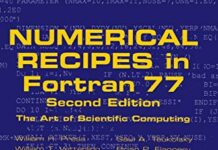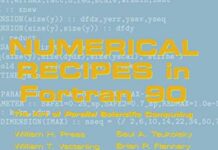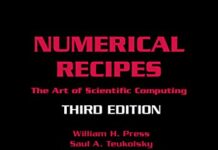
Ebook Info
- Published: 2007
- Number of pages: 1256 pages
- Format: PDF
- File Size: 7.02 MB
- Authors: William H. Press
Description
Co-authored by four leading scientists from academia and industry, Numerical Recipes Third Edition starts with basic mathematics and computer science and proceeds to complete, working routines. Widely recognized as the most comprehensive, accessible and practical basis for scientific computing, this new edition incorporates more than 400 Numerical Recipes routines, many of them new or upgraded. The executable C++ code, now printed in color for easy reading, adopts an object-oriented style particularly suited to scientific applications. The whole book is presented in the informal, easy-to-read style that made earlier editions so popular. Please visit www.nr.com or www.cambridge.org/us/numericalrecipes for more details. More information concerning licenses is available at: www.nr.com/licenses New key features: 2 new chapters, 25 new sections, 25% longer than Second EditionThorough upgrades throughout the textOver 100 completely new routines and upgrades of many more.New Classification and Inference chapter, including Gaussian mixture models, HMMs, hierarchical clustering, Support Vector MachinesNew Computational Geometry chapter covers KD trees, quad- and octrees, Delaunay triangulation, and algorithms for lines, polygons, triangles, and spheresNew sections include interior point methods for linear programming, Monte Carlo Markov Chains, spectral and pseudospectral methods for PDEs, and many new statistical distributionsAn expanded treatment of ODEs with completely new routines Plus comprehensive coverage of linear algebra, interpolation, special functions, random numbers, nonlinear sets of equations, optimization, eigensystems, Fourier methods and wavelets, statistical tests, ODEs and PDEs, integral equations, and inverse theory
User’s Reviews
Editorial Reviews: Review “This monumental and classic work is beautifully produced and of literary as well as mathematical quality. It is an essential component of any serious scientific or engineering library.” Computing Reviews”… an instant ‘classic,’ a book that should be purchased and read by anyone who uses numerical methods …” American Journal of Physics”… replete with the standard spectrum of mathematically pretreated and coded/numerical routines for linear equations, matrices and arrays, curves, splines, polynomials, functions, roots, series, integrals, eigenvectors, FFT and other transforms, distributions, statistics, and on to ODE’s and PDE’s … delightful.” Physics in Canada”… if you were to have only a single book on numerical methods, this is the one I would recommend.” EEE Computational Science & Engineering”This encyclopedic book should be read (or at least owned) not only by those who must roll their own numerical methods, but by all who must use prepackaged programs.” New Scientist”These books are a must for anyone doing scientific computing.” Journal of the American Chemical Society”The authors are to be congratulated for providing the scientific community with a valuable resource.” The Scientist”I think this is an incredibly valuable book for both learning and reference and I recommend it for any scientists or student in a numerate discipline who need to understand and/or program numerical algorithms.” International Association for Pattern Recognition”The attractive style of the text and the availability of the codes ensured the popularity of the previous editions and also recommended this recent volume to different categories of readers, more or less experienced in numerical computation.”Octavian Pastravanu, Zentralblatt MATH Book Description The essential text and reference for modern scientific computing now also covers computational geometry, classification and inference, and much more. About the Author William H. Press holds the Raymer Chair in Computer Sciences and Integrative Biology at the University of Texas at Austin.Saul A. Teukolsky is H. A. Bethe Professor in Physics in the Radiophysics and Space Research Department of Cornell University.William Vetterling is a Research Fellow and Director of the Image Science Laboratory at ZINK Imaging, LLC in Waltham, MA. His career includes eight years on the physics faculty at Harvard and 20 years of numerical modeling and laboratory research on digital imaging at Polaroid Corporation.Brian P. Flannery is Science, Strategy and Programs Manager at Exxon Mobil Corporation. Read more
Reviews from Amazon users which were colected at the time this book was published on the website:
⭐I read parts of this book for knowledge of model building and matrix inversion. I learned a lot by reading the text on these subjects, which I had never done for editions 1 and 2. The paper is very thin; it is easy to deface a page by spilling a liquid on it. Also pages tear easily. The examples actually work, which, as we know, is not true of all computer science books.
⭐I’ve bought several editions of this book: the original one (Fortran code), the C version, and now this latest in C++. I bought this last version mainly for new material on the algorithms, and not for the C++ code.The book is mainly useful for its discussion of the issues involved in numerical analysis, the presentation of algorithms, and — to some extent — the demonstration of the algorithms in code.That said, the biggest weakness of this book is the code itself. The C++ programs appear to be direct translations of Fortran, bringing to mind the old joke that ‘real programmers can write Fortran in any language’. The book would have been far more useful, and the implementations far easier to understand, if the algorithms had been simply written in pseudocode. The code is insufficiently commented, and the variable names are often hard to comprehend. In fact, the code in this book violates almost every precept laid down by Steve McConnell in his excellent — and still relevant — book Code Complete 2nd ed.In that regard, the authors’ concerns about potential copyright violations of their code are almost laughable; no sane programmer writing in C++ (or in Java or C#, or any other modern language, for that matter) would write his/her code the same way as presented in the book.I give this a 4* rating because of how comprehensive this book is and the care the authors take to discuss implementation issues. But I almost knocked it down to 3* because of the horrible coding.
⭐This or a similar book is a must if you do mathematical programming. Algorithms are stable and very fast. That’s on the positive side.On the negative side,1) the physical book’s quality is not great, the binding easily breaks2) the code, while efficient, is barely readable. It is old Fortran style with variables aaa, bbb etc. So you can copy the code, but will have hard time altering it for your needs.3) on occasion the book does not contain the whole algorithm and prompts you to go online.Well, I could go online without paying $100 for the book, and expected the book to be sufficient.Having said this all, I’m still keeping it.
⭐Use this book if you are prepared to read and actually learn from it as opposed to blindly copying the code.Aside from silly copyright restriction, it would not be even worth it – code is simply total garbage. Oftentimes, you are better off *not reading the code*, since it might confuse you. Bad naming conventions, sloppy practices abound.Still, as far as actual content goes, this book is a gem. Down to point descriptions of rationale behind algorithms.They are more than enough to get you going. Don’t listen to detractors who denounce NR as “not professional enough” – meaning it does not contain the most esoteric implementations described in some journal by “experts”.It is easy to go beyond NR if you need to – but this book is a hundreds time better than academic numerical analysis textbooks who won’t actually calculate anything in 600 pages.
⭐I had this book for my Numerical Methods course. This one is a pure gem packaged as a disaster due to following reasons:1) License: Forget about products. If you use this for a course, you can’t reproduce any of the routines for your homework. If you did then the entire class should be booked for copy-right infringement.2) Comments: Authors are extremely reluctant to comment their code. Out of blue variables pop-up. There is no pseudo-code for algorithms and routines are not commented.3) Typos: There are lot of typos. More than you can imagine. Most of the routines miss ; { }.4) Programming practice: If you have dealt with a good code base with just 1000 lines of code, you will get nausea and stomach cramps while analysis every single routine.5) C++: This book is written in C and indexed as C++. There is no C/C++. There is C and there is C++. Authors don’t give a cent about Containers, scoping, type safety, exceptions, etc.6) Numerical Math: Common reason cite by scientific programmers is that this book cover math. The truth is it doesn’t. This is more like “How to write brilliant algorithms in horrible c++ for Numerical Mathematicians.” If you know the theory and find it difficult to express it in code, you will appreciate this one. However, if you don’t learn good programming habits, you will be a jobless programmer.Algorithms are brilliant and well structured topics. But neither can one key-in more than 10 programs nor can they publish better executions for this code base. Theren’t books which are as broad as this one. It is the only reason every Computational Math student is forced to use it.
⭐Useful book, but please be aware you need to be C++ expert to code out all the codes showed in the bookAnd plus, it is saying the code is in C++, but which type of C++ has double been defined as Doub???!!!!so don’t put too much expectation if you’d like to improve your c++ coding skill along with computation math using this book :).
⭐This legendary textbook in its 3rd Edition, takes as into a low flight over the land of almost all scientific algorithms. By using plain C++ one can really master the knowledge that our species managed to formulate into applied and workable computer techniques. Every scientific domain that has already been translated into the language of the well known and understood mathematical methods, in this book will find its perfectly built in C++ computable counterpart. John Piliounis, Physicist, MSc. Electronics Engineering
⭐Would be 5 stars for an interesting and useful product … but some of the pages were quite badly creased (not enough damage to warrant a return – still readable) so I took one off.
⭐I am an old user of Numerical Recipes and, in particular, of the C version (2nd edition). This third edition has for sure expanded its scope (and this is good). However, far too much is not self-contained, and depends on external material in electronic form. We are in the Internet era, but this does not mean a book should not *fully* stand up by itself!
⭐One of the best books of numerical methods. Amazing having it).Some paragraphs were added comparing with the second edition. Like it.
⭐must have foundation
Keywords
Free Download Numerical Recipes 3rd Edition: The Art of Scientific Computing 3rd Edition in PDF format
Numerical Recipes 3rd Edition: The Art of Scientific Computing 3rd Edition PDF Free Download
Download Numerical Recipes 3rd Edition: The Art of Scientific Computing 3rd Edition 2007 PDF Free
Numerical Recipes 3rd Edition: The Art of Scientific Computing 3rd Edition 2007 PDF Free Download
Download Numerical Recipes 3rd Edition: The Art of Scientific Computing 3rd Edition PDF
Free Download Ebook Numerical Recipes 3rd Edition: The Art of Scientific Computing 3rd Edition


